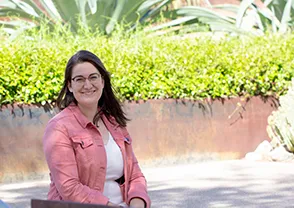Another Wavelength: Emily Finan

This month in Another Wavelength, we chat with Ph.D. Student Emily Finan, currently mentored by Tom Milster.

Where are you from?
I am originally from upstate New York, lived in Hawaii for several years, attended high school in East Tennessee, and I came to Tucson after my B.S. in Physics from the University of Tennessee, Knoxville.
What brought you to study optics?
I followed my passion for astronomy to undergraduate courses in physics, and once I learned about Snell's Law, I was hooked. I had the opportunity to join several condensed matter research projects where I gravitated to the optical spectroscopy experiments including FTIR and pump-probe techniques. From there, I knew I wanted to continue exploring the many ways that light can be engineered and harnessed for real-world applications.
Looking back, I think I have always been interested in optics, though I didn't know it was the underlying thread in my interests until I was introduced to the field in college. I loved astronomy, amateur photography, and was lucky to have an optometrist who indulged my curiosity. At a science fair when I was very young, I saw myself in an infrared camera for the first time and remember thinking that it was the coolest thing I had ever seen; this flashbulb memory now drives my passion for outreach, and I hope that I can create the same experience for future scientists.
Who is your hero in science?
Emmy Noether was a German mathematician who made the connection between mathematical symmetry and physical conservation laws, which I find quite elegant. I am inspired that she had such an impact in math and physics during a time where she was not allowed to formally enroll in and teach university courses as a woman.
I also have always been influenced by science ambassadors; the "Bill Nye the Science Guy" theme song was my first cell phone ringtone, and I had the chance to do a phone interview with Dr. Neil deGrasse Tyson in high school.
Describe your research in 20 words or fewer.
I am developing an adaptive optics microscope for examining diffractive samples.
Describe your research in 200 words or fewer.
When light is focused through a material with varying thickness or refractive index, aberrations are introduced which degrades the image quality. Adaptive Optics (AO) is a technique used to compensate for these aberrations, where phase information is collected with a wavefront sensor which then provides the feedback to the deformable mirror. AO systems are commonly implemented with incoherent objects, such as astronomical observations, microscopy of biological samples, or retinal imaging in ophthalmology. My research focuses on the implementation of these AO techniques to systems with diffractive surfaces and coherent objects, such as illuminating a Blu-ray Disc with a laser.
Light reflected from diffractive surfaces (like gratings or optical storage discs) introduces an additional phase to a microscope system. I analyze how this interference affects AO correction capabilities by using MATLAB simulations and benchtop experiments. This work could be applied to the next generation of optical data storage devices.

Name three neat facts about you.
- I love exploring Tucson outdoors with my dog, Roxie. I've also been sucked in to the unofficial Tucson hobby of rock climbing, but only indoors.
- If you spot me wearing headphones I am catching up with the podcasts I follow. I am always looking for new recommendations for podcasts and audiobooks!
- When I say I am a cheerleader for my friends, I mean this figuratively and literally: I keep pom-poms in my cubicle for thesis defenses.
